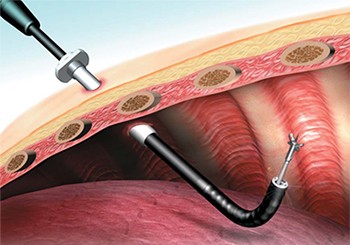 Some people may have an increased likelihood of developing a lung disease because of the genes they inherited from their parents.
Some people may have an increased likelihood of developing a lung disease because of the genes they inherited from their parents.
Genes are short sections of DNA that determine the characteristics of each living organism. Although the DNA sequence is more than 99% identical between different people, there is still scope for more than 10 million potential differences between the gene structure of two people.
Experts use the term genetic susceptibility to refer to genetic factors that may make someone more or less vulnerable to different diseases.
Some diseases, such as cystic fibrosis and alpha-1 antitrypsin deficiency, are caused entirely by genetic factors. These are known as monogenic diseases.
In most other diseases, such as asthma and COPD, it is interactions between a person’s genes and environmental factors, such as allergens, irritants, smoking, diet, nutrients, drugs, infections and injuries, that can lead to the conditions. These are called complex diseases.
HARMFUL EFFECTS
Changes in the genes, known as mutations, have been identified as the cause of many different diseases. These mutations can occur as a result of environmental factors, or they can occur when the sperm and the egg are first produced.
Monogenic Diseases
Cystic Fibrosis
Cystic Fibrosis (CF) is usually caused by problems with a gene called cystic fibrosis transmembrane regulator (CFTR).
The disease is described as an autosomal recessive genetic disorder, which means that mutations must occur in both copies of the gene for the disease to develop.
More than 1,000 different mutations in the CFTR gene have been identified as causing cystic fibrosis. The various mutations affect the expression and function of the CFTR protein, which causes problems with the regulation of salt and water in cells (airways, gut and skin).
Treatment has focused on correcting the underlying defect in the CFTR gene. For example, the drug ivacaftor targets one specific gene mutation, known as G551D, to help reduce symptoms and exacerbations.
Alpha-1 antitrypsin deficiency
Alpha-1 antitrypsin deficiency is also a recessive inherited disorder that affects 1 in 2-5,000 people in Europe.
The disease is characterised by having lower levels of the protein, alpha-1 antitrypsin, in the blood. This protein is coded by the gene, SERPINA1. Mutations to this gene can increase the risk of developing alpha-1 antitrypsin deficiency. Subjects with alpha-1 antitrypsin deficiency are very susceptible to the harmful effects of smoking, leading to the development of severe emphysema at an early age.
Primary ciliary dyskinesia (PCD)
PCD is caused by problems in different parts of the cilia; tiny, microscopic moving hair-like structures that line the airways, ears and sinuses. Some of these problems are caused by mutations of two genes, DNAI1 and DNAH5.
Complex Diseases
Asthma
Research into the genetic causes of asthma focuses on identifying different genes that could make one person more susceptible to developing asthma than another.
Many genes have been associated with asthma, or asthma-related traits such as allergies. The role of these asthma susceptibility genes is not fully understood and research is on-going to understand how they may contribute, alongside environmental factors, to the development of asthma.
This a partial list of selected genes intended as an illustrative example of genetic susceptibility to asthma. LPS: lipolysaccharide; Th: T-helper type 2; IgE: immunoglobulin E.p refers to the short arm of the chromosome. q refers to the long arm of the chromosome. The location numbers after p and q reflect the relative distance to the centromeres of the chromosomes (numbering by convention).
Chronic obstructive pulmonary disease (COPD)
COPD is mainly due to smoking or exposure to other air pollutants. Only about 20% of smokers develop COPD, which suggests that genetic risk factors are involved in the development of the disease.
Only a few COPD susceptibility genes have been firmly identified. These include TNFα (tumour necrosis factor-α), TGFβ1 (transforming growth factor-β1), GSTP1 and GSTM1 (glutathion S-transferases P1 and M1), and SOD3 (superoxide dismutase 3).
Genome-wide association studies in COPD have identified three major susceptibility locations of genes: the FAM13A locus on chromosome 4q22, the locus near HHIP on chromosome 4 and the CHRNA3/CHRNA5 locus on chromosome 15
Research has found that the genes that determine lung function, including the development and growth of the lungs, are also genetic risk factors for COPD.
To help experts identify genes responsible for causing diseases, they first identify common characteristics in people who have a specific condition, such as height, weight or lung function. These characteristics are known as phenotypes. There are some similarities between both asthma and COPD. Several genes, such as TNFα, TGFβ1, MMP12 (matrix metalloproteinase 12) and ADAM33, have been implicated as susceptibility genes for both asthma and COPD.
Pulmonary Fibrosis
Although the cause of pulmonary fibrosis is unknown, it is estimated that up to 2% of cases could be hereditary. Several mutations have been shown to increase susceptibility to pulmonary fibrosis:
- TERT (the telomerase reverse transcriptase gene).
- TERC (the telomerase RNA component gene).
- MUC5B gene.
Sarcoidosis
The causes of sarcoidosis are thought to be a combination of environmental and genetic factors. Although the environmental cause is known, research has identified some genes and gene locations that are thought to be responsible:
- HLA-DRB1 gene on chromosome 6p21.3
- SS2, on chromosome 6p21.32
- ANXA11 gene on chromosome 10q22.3
Lung infections and pneumonia
Illnesses characterised by an impaired immune response to infectious agents, is known as an immunodeficiency.
Several types of defects in the lung, along with genetic defects in the immune system are thought to be responsible for an increased risk of contracting lung infections. These include:
- Deficiency of Toll-like receptor 3 (TLR3) increases susceptibility to viral infections.
- Deficiency of TLR5 increases the risk of Legionella infections.
- Deficiency of mannose-binding lectin increases the risk of infections with bacteria and fungi.
Tuberculosis
Variation in genes has been linked with susceptibility to or resistance against M. tuberculosis, which causes tuberculosis (TB). It is not yet understood why only 10% of people infected with M. tuberculosis go on to develop an active form of the disease.
Lung cancer
Experts have identified a gene that is associated with nicotine addiction and lung cancer. Genome-wide association studies have identified a region on chromosome 15 (15q25.1), containing the nicotinic acetylcholine receptor subunit genes CHRNA3 and CHRNA5. Experts do not yet know whether the risk of lung cancer is increased purely through an increase in nicotine intake, or whether it increases the risk independently of smoking
Pulmonary embolism
Pulmonary embolisms arise from blood clots in the veins. Genetic susceptibility is a risk factor for both blood clots and pulmonary embolism. A mutation in the coagulation factor V gene (called the factor V Leiden mutation) increases the likelihood of blood clots.
When a person has two copies of the factor V Leiden mutation (known as homozygosity), he/she has a two-fold increased lifetime risk of developing deep vein thrombosis, with or without pulmonary embolism.
Nicotine addiction and lung function
The CHRNA3 and CHRNA5 (nicotinic acetylcholine receptor) gene cluster on chromosome 15q24–25 has been linked with dependence on nicotine, measured by the number of cigarettes smoked per day.




